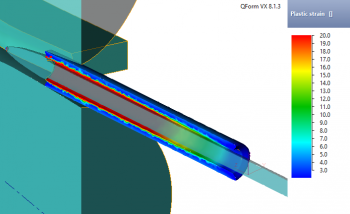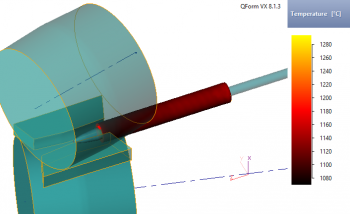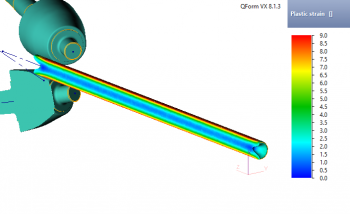Cross-roll piercing and cross helical rolling
 Cross-roll piercing simulation in QForm. Plastic strain distribution field in the cross sectionCross-roll piercing (rotary tube piercing, Mannesmann piercing) and cross helical rolling (three-roll skew rolling) belong to the incremental processes class where deformation occurs in a small localized area of the workpiece and the workpiece itself is processed sequentially to obtain a finished product. The deformation zone is moved around the part as it rotates and thus the deformation is performed in the whole volume.
Cross-roll piercing simulation in QForm. Plastic strain distribution field in the cross sectionCross-roll piercing (rotary tube piercing, Mannesmann piercing) and cross helical rolling (three-roll skew rolling) belong to the incremental processes class where deformation occurs in a small localized area of the workpiece and the workpiece itself is processed sequentially to obtain a finished product. The deformation zone is moved around the part as it rotates and thus the deformation is performed in the whole volume.
The Mannesmann effect is the principal factor in cross-roll piercing where uniform tension occurs in the workpiece, while the rollers, inclined at a small angle relative to the axis of the workpiece, rotate the workpiece.
Good stress-strain state in the deformation zone can be achieved during cross-roll piercing (three-roll skew rolling) which allows production of pipes with uniform macro and microstructure in the cross-cut section of the forged part. This uniform macro and microstructure provides good mechanical properties of the forged parts. Such rolling processes can be performed on three-high rolling mills and two-high rolling mills.
A characteristic feature of cross-roll piercing (rotary tube piercing) and cross helical rolling (three-roll skew rolling) is that metal continuity failure occurs after some reduction of the diameter and this crack propagation forms the cavity in the central part of the workpiece. It is possible to identify the formation of the cavity and the zone where ductile fracture is occurring by estimating the stress-strain state using the QForm software with the implementation of fracture criteria. It is important to establish whether the formation of cavities happens as the result of brittle metal fracture or severe plastic deformation of the workpiece core under the influence of shear stresses (ductile failure).
Especially cross-roll piercing technology is widely used for the production of seamless pipes and casings up to 1.5 meters in diameter.
Such incremental processes are the most complex for simulation and impose specific requirements for the core of solvers and finite element mesh generator:
- A special mesh is required in the moving plastic deformation zone.
- Volume constancy is required throughout the deformation process.
- An acceptable simulation time must be provided while ensuring an accurate calculation.
- Consideration for building finite element mesh in a rotating workpiece body.
The modern software package QForm fulfills all the requirements for modeling cross-roll piercing and cross helical rolling.
 Cross-roll piercing simulation in QForm. Temperature distribution field
Cross-roll piercing simulation in QForm. Temperature distribution field Three-roll skew rolling simulation in QForm. Plastic strain distribution
Three-roll skew rolling simulation in QForm. Plastic strain distribution
Advantages
- Analysis of stress-strain state into the plastic deformation zone between the rolling rolls and piercing punch.
- Evaluation of the influence on process quality of technological factors such as: the shape of the piercing punch, piercing schema, inclination angle of the rolls as well as the influence of structural elements of the piercing mill.
- Prediction of temperature field in the workpiece and the tool.
- Calculation of the stress-strain state and wear of the tool.
- Possibility to study the influence of the inclination angle of the rolls for adjusting new technologies.
Special QForm features that help simulate cross-roll piercing and cross helical rolling
- Importing of cast workpiece from casting simulation software (e.g. ProCAST) for subsequent analysis of porosity in the body of the pipe after piercing.
- Calculation of user subroutines that allow evaluation of product quality (e.g., the Mannesmann effect).
- Special algorithms for calculating processes with the rotating workpiece which reduces the simulation time for such processes.
- Batch mode for adjusting of new production technologies during their implementation.
- A special field of material flow which allows evaluation of surface twisting.
- A specific boundary condition called "pusher" to create conditions for pushing the workpiece at the start time.
- It is possible to use a large number of deforming tools to accurately simulate even the most complex mills.




